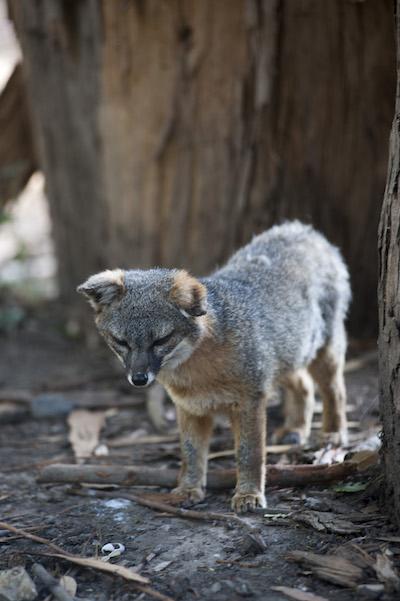
Could low genetic diversity be a problem facing one subspecies of Channel Island Fox?/Patrick Cone
Much was made earlier this year when the U.S. Fish and Wildlife Service announced that three subspecies of the Channel Islands Fox had make a remarkable recovery from the brink of extinction, but one of the species' low genetic diversity could pose grave problems for the animals.
Last month the Service, in proposing to remove three subspecies of the island fox native to the Channel Islands off the Caliornia coast from ESA protection, said the foxes had made "the fastest successful recovery for any Endangered Species Act-listed mammal in the United States."
The removal of the San Miguel, Santa Rosa, and Santa Cruz Island fox subspecies from the Federal List of Threatened and Endangered Wildlife would be an historic success for the multiple partners involved in recovery efforts.
But a report published online March 17 in Molecular Ecology raises concerns about the genetic diversity of at least one of the subspecies. Low genetic diversity was pointed to at Isle Royale National Park for the downfall of that park's wolf packs. So while the numbers of fox on at Channel Islands National Park might have rebounded, a shallow genetic pool could be problematic to their long-term survival, according to the study prepared by Colorado State University researchers.
Chris Funk, associate professor in the College of Natural Sciences’ Department of Biology, led the research team that conducted the largest and most in-depth genetic study to date of California Channel Island foxes. The study "confirmed that each island’s fox population likely warrants designation as a unique subspecies. But it also found that one subspecies, on San Nicolas Island, may require genetic rescue to reduce its risk of extinction," a release from the university said.
The San Nicolas Island fox has the lowest genetic variation ever found in a mammal species, making them especially vulnerable.
“Low genetic diversity may lead to lower survival and reproductive success, and may reduce the ability of a population to adapt to climate change or new, introduced diseases,” Professor Funk said in a release. “With a dwindling population of fewer than 300 adults, actions need to be taken quickly to preserve this important member of the Channel Islands ecosystem.”
Specifically, the report raised the question of whether a "genetic rescue" is necessary by bringing island fox individuals from other islands to boost the San Nicolas gene pool.
The island fox is the smallest fox species in the United States and found on six of the eight California Channel Islands. Four of the six fox subspecies (not including the San Nicolas population) were listed as endangered under the U.S. Endangered Species Act in 2004 due to precipitous population declines caused by predation by golden eagles and an epidemic of canine distemper virus. Since then, concerted efforts by various island managers enabled island fox numbers to recover sufficiently that the U.S. Fish & Wildlife Service plans to remove or move them down the list.
“The recent island fox recovery was the result of an impressive collaboration of scientists and land managers. It may now be time to examine whether unconventional methods like genetic rescue are needed for the San Nicolas Island fox,” said Scott Morrison, The Nature Conservancy’s director of science and a coauthor of the study.



Add comment